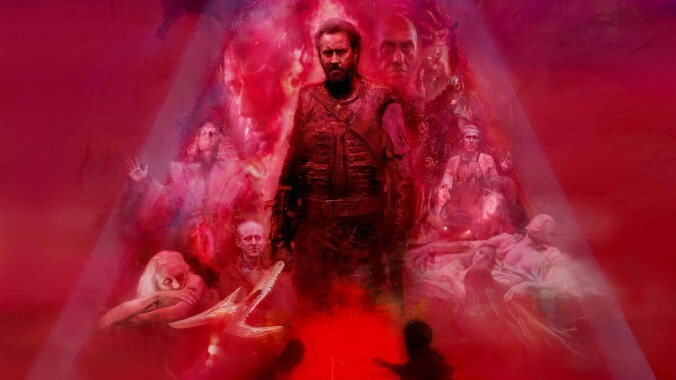Panos Cosmatos knows his audience. But does he know anything else? Both of his films to date (Beyond The Black Rainbow, the new Mandy) have been exercises in psychotronic drag-ass, best appreciated by a certain kind of movie freak—the devotees of the church of The Texas Chainsaw Massacre 2 and Heavy Metal, in Mandy’s case. Its ritualization of taste markers begins with the opening credits: the lachrymose Robert Fripp guitar work of King Crimson’s “Starless” over an aerial shot of pines and a paperback-cover typeface. We are introduced to Red Miller (Nicolas Cage), a logger and ex-something; his girlfriend, the title character (Andrea Riseborough); their quiet home in the woods, a locus amoenus of imperfections that fit together just right. It is, of course, the 1980s, era of big T-shirts (Sabbath, Crüe), big couches, and Reagan. He is older, with a tough guy’s tattoos; she has a big, memorable facial scar and an otherworldliness that belies the biker-chick look. They’ve gotten away from vague, violent pasts; in the here and now, they are soul mates. They spend their time talking about planets and dreams.
Enter the “weirdo hippie types,” an LSD cult led by Jeremiah (Linus Roache), a stringy-haired failed singer-songwriter of the previous decade. He sets his eye on Mandy and dispatches his unprepossessing, doltish minions to snatch her with the help of the Black Skulls, an infernal trio of pain-loving bikers in gimp suits and spiky metal. The buildup is as deliberate and intractable as sludge, but so is the follow-through. It takes a solid hour before Red goes after Jeremiah and the Skulls, the initially underplayed performance cracking into unhinged Cage-mania; the next hour is a drawn-out blood sacrifice to the grindhouse gods. Heads are crushed and severed, throats are cut and penetrated with sharp objects, and the red stuff gushes. Armed with a crossbow and a hand-forged Dungeons & Dragons ax, our bug-eyed avenger cuts an archetypal figure against the nowhere-ness of the setting, a vague Pacific Northwest of logging roads and rock quarries. (The film was actually shot in Belgium.) The white part of his lucky baseball tee is soaked red with blood. The doom-metal influenced original score (by the late Jóhann Jóhannsson) growls.
Not that Mandy lacks of sense of humor, sick or otherwise. Roache’s prissy, acid-dosing messiah is consistently funny—and anyway, this is a movie that features a chainsaw duel and Cage, in full bug-eyed-and-grimacing mode, snorting scoops of cocaine and lighting a cigarette off a vanquished foe’s flaming severed head. Its central conflict is between different meanings of “cult”: the kind that oppresses, embodied by Jeremiah and his brainwashed followers; the kind that brings pleasure, embodied by Mandy’s love of sword-and-sorcery fantasies, Cage’s hypnotic overacting (now in its “fat Elvis” phase, for better or worse), and by Cosmatos’ mannerist reinterpretation of midnight movies and high-grade ’80s supercheese. (The last one is a family business; his father, the late George P. Cosmatos, directed Cobra and Rambo: First Blood Part II.) The look of the film is a hoot: double lens flares over wood paneling, psychedelic lighting, crude animated sequences, slow-mo and telephoto shots, and enough vintage MTV fog machines to kill a hair metal band.
An ad for a fictitious Kraft Mac & Cheese competitor called Cheddar Goblin (complete with a mascot who regurgitates gallons of mac) sums it up: It’s got double the cheese of the leading other brands. But at 121 languorous minutes, Mandy feels both heavy and superficial. The reconfiguration of genre violence, fetishes, and animal imagery (tigers, in this case) into a Manichean myth with a self-destroying hero smacks of Nicolas Winding Refn. But with the exception of one striking Fritz Lang-ian effect—Mandy’s face lysergically morphing into Jeremiah’s mid-trance—Cosmatos maintains an ironic distance from his simplistic ideas of good and evil. The film is about nothing—aside, of course, from the sight of a blood-spattered Nicolas Cage gritting his teeth as he rams the sharpened knob of his ax down someone’s throat. For the right palate, that can be enough.










![HBO teases new Euphoria, Larry David, and much more in 2026 sizzle reel [Updated]](https://img.pastemagazine.com/wp-content/avuploads/2025/12/12100344/MixCollage-12-Dec-2025-09-56-AM-9137.jpg)






























